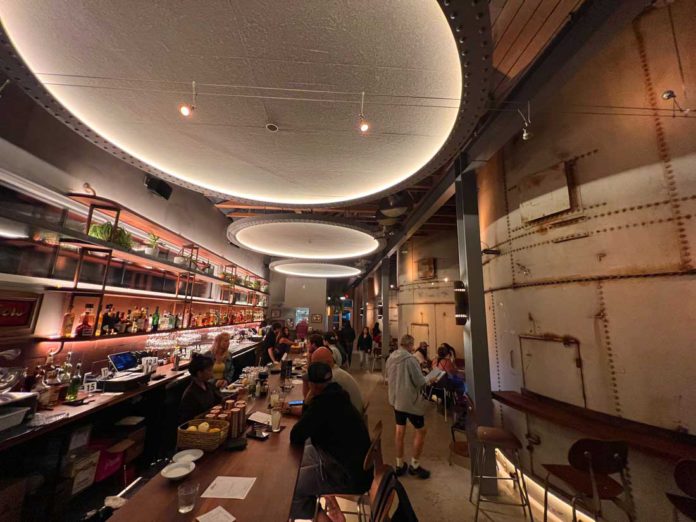Morgan Hill has been evolving over the past decade, with new housing and a growing number of eateries bringing fresh energy to the town. While the surrounding areas still hold onto their agricultural roots, the town itself has embraced its small-town charm.
One of the newest spots to embody this balance of old and new is Silos, a restaurant that not only gives a nod to the town’s agricultural past, but also brings a modern edge to the dining scene. Built around four original silos by the train tracks from Morgan Hill’s farming days, the restaurant’s design seamlessly blends rustic charm with contemporary style.
A series of framed photographs document the restaurant’s construction, telling the story of how Silos came to be, documenting the process of tearing down some of the original silos and building the new structure around the ones that remained. It’s a fascinating look at how the past was preserved while something completely new took shape, blending rustic charm with a modern edge.
The space itself is long and narrow, with dining tables along one side and a long sleek black walnut bar anchoring the other. The industrial feel, with its cement base and exposed beams, is softened by warm lighting and earthy tones.
Gray walls and a clay-colored tile backsplash behind the bar add texture, while touches of greenery—like the succulents lining the top shelves—bring life to the room. Vintage cocktail books are tucked off to the side, giving a nod to the bar’s focus on craft mixology.
Above, three large circular light fixtures, repurposed from actual parts of the original silos, tie the space together fully. Hanging from the ceiling are old farming tools, further connecting the restaurant to Morgan Hill’s agricultural past. The result is a space that feels both timeless and contemporary, blending rustic and modern elements.
But it’s not just the design that makes Silos stand out—it’s the collaboration between owner Ross Hanson and Chef Jacob Farleigh. Hanson, whose success with Oak & Rye in Los Gatos has earned him a solid reputation, brings his creative vision and laid-back approach to the space.
Working alongside him, Farleigh—whose experience includes Michelin-starred kitchens like Manresa and Dio Deka—adds his fine dining expertise to the menu. Together, they’ve crafted a lineup of dishes that are inventive yet approachable, giving diners a taste of something both familiar and refined.
The same attention to detail carries over to both the food and cocktail menus. It’s clear that thoughtfulness runs through everything. The cocktail menu leans heavily into craft, with each drink showcasing the bar’s expertise in blending flavors and creativity.
On the food side, I started with some of the lighter snacks like the pickled eggs, a simple but flavorful option with a tangy bite that worked as a great palate opener. Then came the French onion dip with kettle chips—a classic combination, but done with care, making the dip rich and smooth, with tiny bits of green onion for texture.
Next up was the Cacio e Pepe Gougeres, which (though I struggle to pronounce) I can confidently say was a highlight of the night. These delicate puff pastries were perfectly airy inside, with a subtle crispness on the outside that balanced the cheesy, savory flavors. The richness was taken to an even deeper level when I dipped them into the French onion dip, thanks to a great recommendation from one of the staff.
Following that, the Silos Salad brought a fresh mix of iceberg lettuce, radicchio, salami, provolone, and garbanzo beans, offering a hearty but refreshing change of pace. But the standout of the meal came later with the braised beef chili.
At first glance, it almost looks like a French onion soup, with a layer of cornbread baked on top where you’d expect the cheese to be. Beneath that, the rich, meaty chili delivered bold, hearty flavors, with just the right amount of spiciness to leave a lasting heat after each bite. The juicy cuts of beef add an extra layer of satisfaction, and the way the textures and flavors of the chili and cornbread come together makes every bite feel like pure comfort.
After the chili, the whole roasted maitake mushrooms au poivre was another standout, offering a surprising twist. Served with creamy polenta, Gruyere cheese, and warm, juicy tomatoes slow-cooked in olive oil, this vegetarian dish felt just as hearty as its meat-based counterparts.
What really pulled everything together was the flavorful vegetarian steak gravy. The tangy tomatoes, earthy mushrooms, and rich polenta worked so well together, and the gravy added that perfect savory touch, making the whole dish feel both hearty and satisfying. What’s even more interesting is that a good portion of the menu is available in vegetarian options, a welcome surprise for those looking for plant-based choices without sacrificing any flavor.
The drink menu includes a solid selection of wines and beers, but the real star is their craft cocktail lineup curated by the talented bar team. I kicked things off with the Oak & Rye, a cocktail that is not only a nod to their sister restaurant but one that balances bold spice with bright citrus. It was smooth, complex in flavor, and paired perfectly with the meal without overpowering any of the dishes.
For dessert, I opted for a freshly baked peanut butter cookie paired with an espresso martini. The cookie was warm, with a soft center that had just the right amount of crunch around the edges, striking a balance between sweet and savory.
The espresso martini, rich and bold, added a layer of decadence to the pairing. The deep coffee flavors of the martini played beautifully off the nuttiness of the cookie, making for a dessert that was both comforting and indulgent.
Silos is quickly making its mark on Morgan Hill’s dining scene. On my visit, it was clear that many of the locals seemed to know each other, further adding to the welcoming and close-knit vibe. Hanson, along with his wife Bree and Chef Farleigh, have created a concept that’s both refined and inviting. As Morgan Hill continues to evolve, Silos is set to play a central role in the town’s growing food culture.









Exciting!! Do they take reservations? What’s their contact info? Address? Website or phone number?